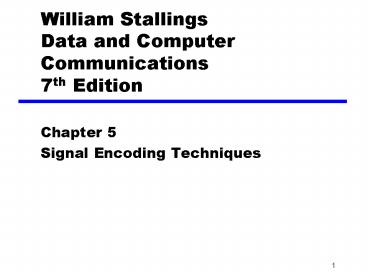William Stallings Data and Computer Communications 7th Edition - PowerPoint PPT Presentation
1 / 24
Title:
William Stallings Data and Computer Communications 7th Edition
Description:
Modulation rate. Rate at which the signal level changes ... Why modulate analog signals? Higher frequency can give more efficient transmission ... – PowerPoint PPT presentation
Number of Views:141
Avg rating:3.0/5.0
Title: William Stallings Data and Computer Communications 7th Edition
1
William StallingsData and Computer
Communications7th Edition
- Chapter 5
- Signal Encoding Techniques
2
Encoding Techniques
- Both analog and digital information can be
encoded as either analog or digital signals - Digital data, digital signal simplest form,
binary ones and zeros - Digital data, analog signal Modem converts
digital data to analog signal to transmit over
analog line - Analog data, digital signal digitize analog
data for digital transmission - Analog data, analog signal no conversion
(voice, telephone)
3
Digital Data, Digital Signal
- Digital signal
- Discrete, discontinuous voltage pulses
- Each pulse is a signal element
- Binary data encoded into signal elements
4
Terms (1)
- Unipolar
- All signal elements have same sign (either
positive OR negative - Polar
- One logic state represented by positive voltage
the other by negative voltage - Data rate
- Rate of data transmission in bits per second
- Duration or length of a bit
- Time taken for transmitter to emit the bit
5
Terms (2)
- Modulation rate
- Rate at which the signal level changes
- Measured in baud signal elements per second
- Mark and Space
- Binary 1 and Binary 0 respectively
6
Interpreting Signals
- Need to know
- Timing of bits - when they start and end
- Signal levels (0 vs. 1)
- Factors affecting successful interpreting of
signals - Increased data rate, increased bit error rate
(BER) - Increased noise, increased BER
- Increase bandwidth enables an increased data rate
7
Comparison of Encoding Schemes
- Need to be able to determine beginning and end of
each bit (clocking or synchronization) - Error detection
- Can be built in to signal encoding (parity, check
sum, etc.) - Signal interference and noise immunity
- Some codes are better than others
- Cost and complexity
- Higher signal rate ( thus data rate) lead to
higher costs
8
Digital Signal Nonreturn to Zero-Level (NRZ-L)
- Two different voltages ( and OR and none)
for 0 and 1 bits - Voltage constant during bit interval
- no transition I.e. no return to zero voltage
- e.g. Absence of voltage for zero, constant
positive voltage for one - More often, negative voltage for one value and
positive for the other
9
NRZ
10
NRZ pros and cons
- Pros
- Easy to engineer
- Make good use of bandwidth
- Cons
- dc component
- Lack of synchronization capability
- Used for magnetic recording
- Not often used for signal transmission
11
Modulation Rate
12
Digital Data, Analog Signal
- Public telephone system
- 300Hz to 3400Hz
- Use modem (modulator-demodulator)
- Amplitude shift keying (ASK)
- Frequency shift keying (FSK)
- Phase shift keying (PK)
13
Modulation Techniques
14
Amplitude Shift Keying
- Values represented by different amplitudes of
carrier - Usually, one amplitude is zero
- i.e. presence and absence of carrier is used
- Susceptible to sudden gain changes
- Inefficient
- Up to 1200bps on voice grade lines
- Used over optical fiber
15
Binary Frequency Shift Keying
- Most common form is binary FSK (BFSK)
- Two binary values represented by two different
frequencies (near carrier) - Less susceptible to error than ASK
- Up to 1200bps on voice grade lines
- High frequency radio
- Even higher frequency on LANs using co-ax
16
Multiple FSK
- More than two frequencies used
- More bandwidth efficient
- More prone to error
- Each signalling element represents more than one
bit
17
Phase Shift Keying
- Phase of carrier signal is shifted to represent
data - Binary PSK
- Two phases represent two binary digits
- Differential PSK
- Phase shifted relative to previous transmission
rather than some reference signal
18
Differential PSK
19
Analog Data, Digital Signal
- Digitization
- Conversion of analog data into digital data
- Digital data can then be transmitted using NRZ-L
- Digital data can then be transmitted using code
other than NRZ-L - Digital data can then be converted to analog
signal - Analog to digital conversion done using a codec
- Pulse code modulation
20
Digitizing Analog Data
21
Analog Data, Analog Signals
- Why modulate analog signals?
- Higher frequency can give more efficient
transmission - Permits frequency division multiplexing (chapter
8) - Types of modulation
- Amplitude
- Frequency
- Phase
22
Analog Modulation
23
Required Reading
- Stallings chapter 5
24
Chapter 5 Review Questions
- List and briefly define factors used to evaluate
or compare the various digital-to-digital
encoding techniques - What do you need to know in order to interpret a
signal? - What is the difference between NRZ-L and NRZI?
- What function does a modem perform?
- How are binary values represented in ASK?
- Compare and contrast ASK, FSK, and PSK.































